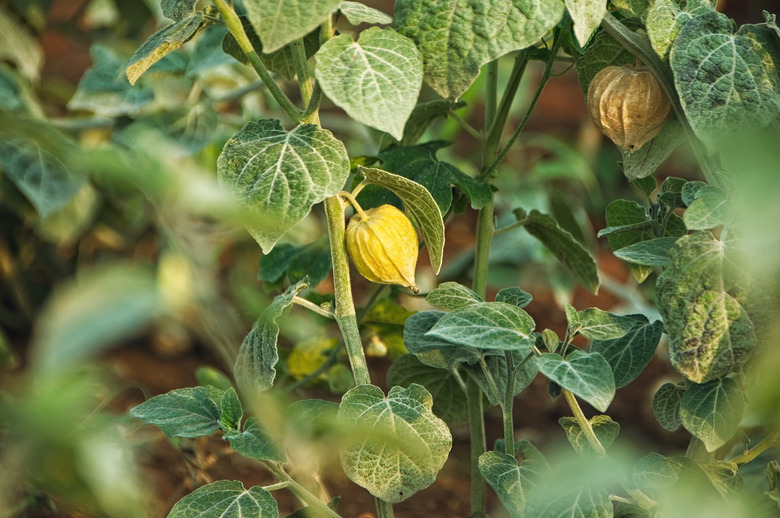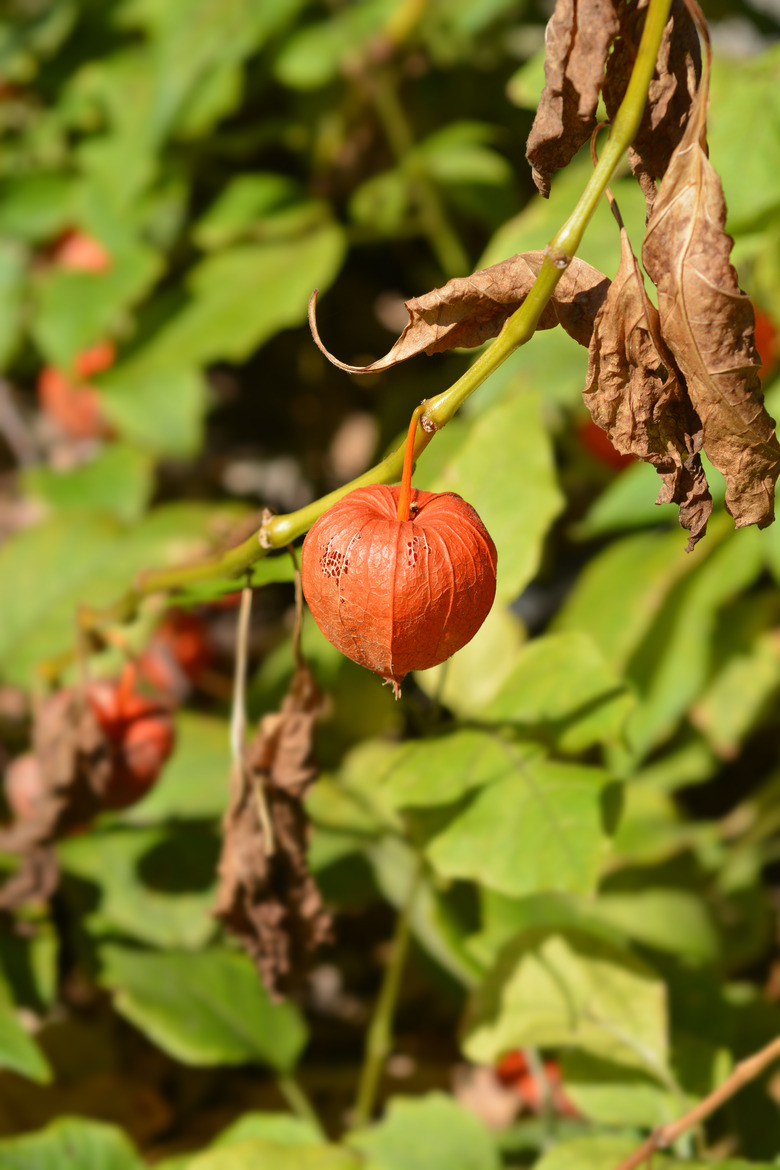How To Grow Ground Cherries
We may receive a commission on purchases made from links.
- Best uses for ground cherries
- How to grow ground cherries
- In what zone do ground cherries grow best?
- When should you plant ground cherries?
- Soil, sunlight and water recommendations for ground cherries
- How to propagate ground cherries
- How to winterize ground cherries
- How to harvest ground cherries
- Common pests and other problems for ground cherries
- Common diseases for ground cherries
The ground cherry (Physalis spp.) is a perennial in the nightshade family and is a relative of the tomato. The plant produces odd, interesting and delicious cherry-like fruit, each enclosed in a papery husk. Ground cherry plants are also called cape gooseberries, goldenberries, puha fruit, husk cherries and husk tomatoes. The diversity of the common names for this plant makes it clear that this is not a garden-variety fruit plant.
Ground cherry plants grow to 3 feet tall with purple-hued spreading branches and velvety, heart-shaped leaves. Their yellow, bell-shaped flowers appear in summer and then give way to the husk-covered fruit. Some species are native to the tropics of South America, while other species are native to the U.S. The plant is hardy in U.S. Department of Agriculture plant hardiness zones 6 through 11, depending on species. However, it can be grown as an annual in cooler climates.
Best Uses for Ground Cherries
Best Uses for Ground Cherries
Ground cherries are attractive plants with deep, ribbed foliage, but they are most often grown for the unusual and delicious fruit. The plant is best grown in an area that gets plenty of sun, no frost and some protection from strong winds. In the backyard, you might site it near a south-facing wall or even in a patio area to keep it out of the air currents.
Depending on hardiness zones and species, the plants can be grown as perennials in many climates and will produce fruit for four years or more without replanting. However, it's possible to grow ground cherry plants as annuals in most regions of the country. They are easy-care plants that thrive on neglect as long as they get generous amounts of water on a regular basis. You can grow them in garden beds or in containers.
How to Grow Ground Cherries
How to Grow Ground Cherries
- Common Name: Ground cherries
- Botanical Name: Physalis spp.
- When to Plant: Sow seeds as early as possible, ideally by February. Plant rooted cuttings in mid-May.
- USDA Zones: 6-11, depending on species
- Sun Exposure: Full sun
- Soil Type: Moist, well-draining soil
- When it's in Trouble: With inadequate irrigation, this plant will die. Consistent irrigation is essential.
- When it's Thriving: Pretty foliage and branches hanging heavy with bright summer flowers, turning to fruits in papery pods in August
Starting Ground Cherries From Seed
If you are starting ground cherries from seed, start early, ideally in February. The seeds may be available in the local garden store. If not, buy them from a specialty garden store online or use seeds from last year's fruit. Look for Aunt Molly's Ground Cherry (Physalis pruinosa 'Aunt Molly's'), a particularly attractive Polish heirloom. To collect your own seeds, split open the fruit, remove the seeds with tweezers and then dry them for a few weeks in a warm location before sowing.
Ground cherry isn't picky about soil as long as it is well-draining. Fill planting pots with normal potting soil, moisten the soil and then sprinkle the seeds onto the surface. It may help to mix them with some sand to spread them more evenly. Press them into the soil lightly with a finger.
Put the containers in a warm spot with some sun. The plants won't germinate without sunlight. Use a spray bottle to keep the seeds and soil moist. Germination can occur in a few days or a few weeks. Keep spraying the soil as needed and allow the little seedlings to grow on their own until the middle of May. At that point, it's time to transplant them into the garden.
Starting Ground Cherries From Seedlings
If you live in a big city, it's possible that you may find ground cherry plant seedlings at a garden store. In smaller towns or rural areas, this isn't likely to be the case. You can sometimes find these seedlings online. If not, you'll need to start your own seeds and then move the seedlings to the garden in mid-May.
Transplant the seedlings into a sunny garden plot that is protected from prevailing winds. The soil should be well-draining and ideally sandy or gravelly. Install each seedling into the ground so that it is at the same level in the soil surface as it was in the container. Space the plants some 3 feet apart to allow plenty of room for them to grow to their mature size. If you prefer, plant them in large containers (at least 3 gallons) on the porch or patio.
In What Zone Do Ground Cherries Grow Best?
In What Zone Do Ground Cherries Grow Best?
Depending on species and cultivar, ground cherry plants are hardy in U.S. Department of Agriculture plant hardiness zones 6 through 11. That means if you live in these warm zones, you can plant ground cherries one year, and they will live for a number of years. Some report perennials producing fruit for 10 years. Keep perennial ground cherry plants in a protected area, like near a south-facing wall, to shield them from harsh winds.
Ground cherries can grow just as well as annuals in most other regions. That means you plant them in spring, harvest them in fall and then dispose of the plant. It might be possible for those growing ground cherries in pots in a cooler zone to overwinter the plants indoors. That would involve bringing them into a heated area and providing some sunlight and water. The plants will not survive a cold winter outside.
When Should You Plant Ground Cherries?
When Should You Plant Ground Cherries?
Generally, experts recommend that you start seeds as early as possible in the year for a same-year harvest. February is said to be the ideal month to put seeds in the ground, while May is the time to transplant. Those living in areas with mild winters should have no trouble, but in cooler areas, you'll need to start the seedlings indoors. They won't germinate in freezing weather, and one sharp frost might kill them.
Soil, Sunlight and Water Recommendations for Ground Cherries
Soil, Sunlight and Water Recommendations for Ground Cherries
Ground cherries are not particular about soil type. They thrive in any well-draining soil, although they seem to prefer soil that is mixed with sand or small gravel. Nutrients are less important than drainage, and it is possible to get consistently good crops on poor, sandy soil without any fertilizer. In fact, even mild fertilizer encourages rampant foliage growth at the expense of flowers and fruit.
The plants need sun and warmth. Ground cherry plants will do best in a sunny, frost-free location. Position them near a wall to give them additional warmth and to protect them from strong winds. If you fear a frost, cover the plants with plastic sheeting or fabric row covers. If they get leggy, pinching back the shoots gets you a more compact ground cherry.
Consistent irrigation is a must for ground cherries. If you let the plants dry out, you will seriously limit your fruit crop. This plant goes dormant and stops all growth during a drought. Overwatering is usually only a problem when the soil isn't well-draining. If your soil doesn't drain well, consider raised beds or at least mounded rows.
How to Propagate Ground Cherries
How to Propagate Ground Cherries
Ground cherry plants can be propagated from stem cuttings. The resulting plants will flower early and fruit generously, but they won't have the same vitality as seedling-grown plants.
To propagate ground cherry plants from cuttings, make 4- to 6-inch cuttings from last year's shoots. Take each cutting from a leaf axil in autumn using a long, diagonal cut. Alternatively, take slightly longer cuttings and then recut the shoot on a long diagonal to allow maximum uptake of water and nutrients.
Treat the cut area with rooting hormone to increase your chances that the plant will grow roots. After they are treated, poke the shoots into plant pots filled with normal soil. Keep them in a warm location where they will get indirect light but no direct sun. It's also important to keep the soil moist. Over time, the little cuttings should root. Plant the rooted cuttings in mid-May.
How to Winterize Ground Cherries
How to Winterize Ground Cherries
If you live in a climate where ground cherries won't survive outside in winter, you can pot them and bring them into a heated area for the cold months. Put this on your fall to-do list. Be sure to provide them with some light and consistent water. It helps to prune them back just before you bring them inside. This can give them a running start for new growth in spring.
How to Harvest Ground Cherries
How to Harvest Ground Cherries
The flowers bloom and fade by midsummer, and the fruit itself starts to develop. The fruit is hidden inside a little sheath of many green leaves. The sheath looks particularly impressive since it is considerably larger than the fruit itself. These leaves wilt and die back as the fruit ripens. By the time the sheaths are straw-colored with an orange tinge, it is time to try the fruit.
Pick one or two fruits for tasting. Strip off the sheaths and taste the round balls inside. If they aren't sweet, wait another week and then try again. The mature fruit should be a yellow-orange color and sweet, tart and fresh, not unlike grapes. Different varieties and cultivars are slightly different shades and sizes.
Common Pests and Other Problems for Ground Cherries
Common Pests and Other Problems for Ground Cherries
Underwatering is the most serious problem for sweet cherries. Consistent water is necessary for the plants to flower and fruit. Overfertilization will increase foliage size and amount but decrease flowers and fruit.
Cut worms can attack young seedlings. Put plant collars around the seedlings or sprinkle ground eggshells at the base of the plant. Tomato hornworms are chubby caterpillars that munch at night, so head out with a flashlight and pick them off by hand.
Colorado potato beetles are small, yellow-and-black-striped beetles that you should pick off by hand. Flea beetles are tiny beetles that don't do much harm other than eating holes in the foliage.
Common Diseases for Ground Cherries
Common Diseases for Ground Cherries
You'll recognize powdery mildew right away since it looks like someone sprinkled powdered sugar all over your plant. This is a fungal disease, usually occurring when water sits on the foliage leaves. Water the base but not the leaves and treat by spraying with neem oil.
Root rot is almost always a consequence of improper drainage. If water gets caught and held in the soil, the roots simply rot. If your soil is heavy or clay, amend it well with organic matter or plant in a raised bed with potting soil that drains well.


